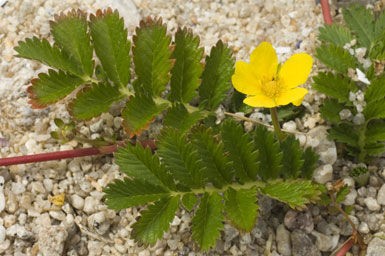Silverweed Cinquefoil
(Argentina anserina anserina)

Description
Argentina anserina (synonym Potentilla anserina) is a perennial flowering plant in the rose family, Rosaceae. It is known by the common names silverweed, common silverweed or silver cinquefoil. It is native throughout the temperate Northern Hemisphere, often on river shores and in grassy habitats such as meadows and road-sides. The plant was originally placed in the genus Potentilla by Carl Linnaeus in his Species plantarum, edition 1, (1753) but was reclassified into the resurrected genus Argentina by research conducted in the 1990s. The reclassification remains controversial and is not accepted by some authorities. It is a species aggregate which has frequently been divided into multiple species. Silverweed is a low-growing herbaceous plant with creeping red stolons that can be up to 80 cm long. The leaves are 10–20 cm long, evenly pinnate into in saw-toothed leaflets 2–5 cm long and 1–2 cm broad, covered with silky white hairs, particularly on the underside. These hairs are also present on the stem and the stolons. These give the leaves the silvery appearance from which the plant gets its name. The flowers are produced singly on 5–15 cm long stems, 1.5-2.5 cm diameter with five (rarely up to seven) yellow petals. The fruit is a cluster of dry achenes. Silverweed is most often found in sandy or gravelly soils, where it may spread rapidly by its prolific rooting stolons. It typically occurs in inland habitats, unlike A. egedii, which is a salt-tolerant coastal salt marsh plant. The plant was put in shoes to absorb sweat. It was formerly believed to be useful for epilepsy, and that it could ward off witches and evil spirits. The plant's roots were eaten by some Native American tribes. It has been cultivated as a food crop for its edible roots, which resemble parsnips. It may also become a problem weed in gardens. The pre-Linnaean name anserina means "of the goose" Anser, either because the plant was used to feed them or because the leaves reminded of the bird's footmarks. In Sweden, the flower is called goose-wort. A rich folklore has developed around Silverweed. The plant bears the common name of richette in French, being rich through both silver and gold. There is a legend that the Christ Child grew up and walked the roads of Palestine; and the yellow flowering plant of the dusty wayside with silvery fern-like leaves that lay flat on the ground has been called the Footsteps of Our Lord.
Taxonomic tree:







